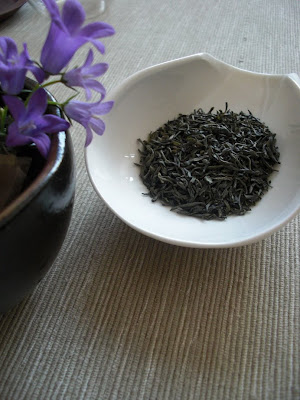
As the temperature outside keeps getting more and more enjoyable, air fills with smell of blossoming flowers and ever-present singing birds, we naturally start to crave for something greener, lighter and cooler, something to harmonize the body with tempo of changing weather. Luckily enough, some early-spring first picks of fresh teas are already available – naturally the most suitable and enjoyable option to satisfy the craving.

I've been able to try two 2011 teas so far – Yunnan Mao Feng from Teatrade.sk's offering and Hai Nan Bai Sha Lu from Nomad.sk. Both of these teas were picked in February and both are Chinese, though they originate in different provinces and vary quite a lot in processing.
This post isn't really supposed to compare; its main purpose is just to share the joy.

At the series of tea tastings organized by Teatrade last summer, I've got accustomed to preparing fresh Chinese green teas in tall glass cup instead of a gaiwan (though I casually still use it for these teas as well, it just depends on the mood). Their Mao Feng is therefore prepared in this style; its big, curly greenish leaves with quite a lot of young buds are poured into the preheated double-wall glass thermos, immediately intensifying the fresh, flowery and herbaceous smell, so typical for early pan-roasted Yunnan greens.

I use longer brewing times and quite hot water for this Mao Feng; even so, it remains very light, mild and clear, just as the early spring itself. The color of its brew is very transparent greenish-yellow, corresponding with the taste, which is light, smooth, nutty and flowery, cooling in mouth and has slightly buttery aftertaste.

Its freshness is nicely represented by vivid herbaceous note, especially reminding me of green nettle and brew made of its fresh young buds (often consumed in Slovak countryside, especially as a traditional medicament – I don't know about other countries, though).

The second tea is Bai Sha Lu from Wu Zhi Mountain of Hainan, the smallest and southernmost province of China. It's leaves show some characteristics of the way it was processed – in contrast to Mao Feng, these leaves were steamed and chopped, resulting in quite short, uniform appearance and mat, light green color. Their smell is thicker, deeper and fruitier with slight reminiscence of Japanese green teas (which are, after all, processed in a very similar way).

Also prepared in glass, this tea gives yellow infusions, also somehow “thicker” in character, very sweet and complex, pleasantly heavy and with tones of ripe fruit, especially plums and apples. Further infusions also show slight spiciness, especially vivid in aftertaste.
Though this tea is much heavier and less flowery-light than the pan-roasted Yunnan Mao Feng, it also posses the typical spring character, which, however, shows up in a completely different - and likewise interesting - way.

Only few things can bring such peace to mind as drinking fresh tea in the afternoon sun. Judging from these two early birds, it seems like there is definitely a lot to look forward to about this year's harvest in China.





















